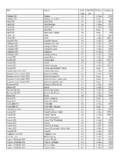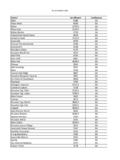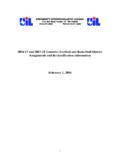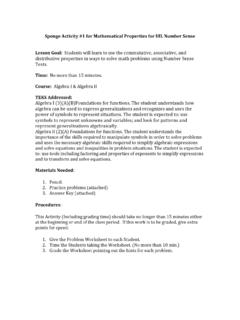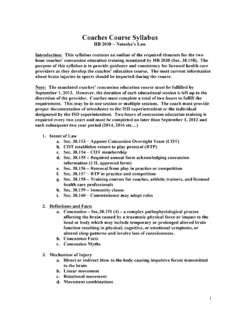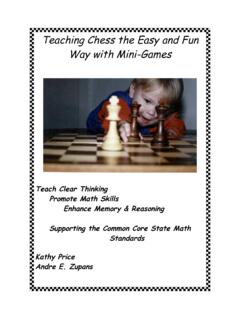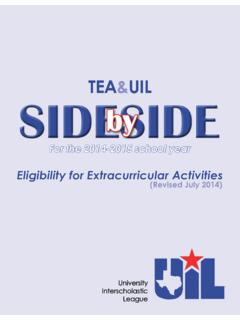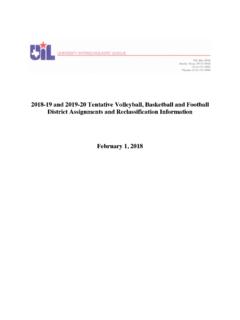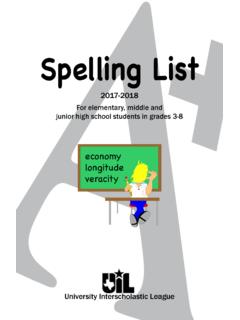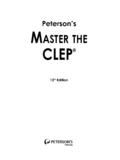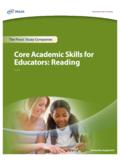Transcription of NS Tips for Coaches - University Interscholastic …
1 UIL Number Sense Contest Practice and Test Taking tips For Coaches Larry White UIL State Number Sense Contest Director Number Sense ---- The ability to work quickly with numbers and solve problems in your head without the use of other materials. UIL Contest information 1. The number sense test has 80 problems. (see sequence chart) 2. The test has a 10 minute time limit. 3. Erasing, mark-overs, and/or scratch work is not permitted. 4. Scoring is plus 5 points for each correct answer and minus 4 points for each wrong answer or skipped problem up to the last one attempted. Why do UIL Number Sense? Competition Team work Scholarships Mind stretching Ability to think on ones feet UIL Number Sense in the regular classroom Can help create mind thinking .. Can help stretch mind speed .. Can help strengthen mind confidence.
2 Can be a good review of concepts for TAKS .. Can be used to introduce new and exciting tricks to work old problems .. Can be used to introduce new concepts .. Can help create competitiveness and be used for fun .. Can be used for sponge activities .. Can be used as extra credit to help recover from a bad grade .. Can help students become self-challenged and self-motivated .. page 1 Resources for Help Number Sense tests are written on three levels: Elementary (grades 3-6) Middle School (grades 7-8) High School (grades 9-12) Books No Sense in Mathematics by Don Skow Mental Mathematics for Number Sense by Frances Walzel RAM Materials by Leo Ramirez ( ) Middle School and High School Packets Dr. John Hobbs (call 972-442-3168) Practice Tests University Interscholastic League (UIL) ( ) Texas Math and Science Coaches Association (TMSCA) ( ) RAM Materials by Leo Ramirez ( ) AMT Test Writing Service by Andy Zapata Computer Software Number Sense Computerized by Larry White ( ~texasmath/) UIL Number Sense Mental Math Mentor ( ) Websites UIL - TMSCA - Texas Competitive Mathematics - Math Magic - Dr.
3 Numsen - Math Forum - MATHNERDS - page 2 Practice tips Speed and accuracy comes from increased knowledge and practice not from taking tests! 1. Create note card rings --- have 3x5, 4x6, etc. note cards available to put an example of a problem on one side and the shortcut on the other side --- create a new card as they learn each new shortcut. 2. Knowledge --- work on groups of 20 --- (see the sequence chart) > Run off 5 practice sheets from the same test with just problem #1-20. > Have the students work #1-10 on one of the practice sheets using pencil and paper or mentally. Have them write the correct answer next to their answer. > Have them create an index card for any shortcuts they came across if they know one. Students should share each others shortcuts, so they can add them to their rings. > Then have them circle the number of each problem that they couldn t do quickly.
4 These are the ones that need to be looked at carefully for a possible shortcut or a quicker way to work them. > Now do the same 10 problems on another one of the practice sheets using pencil and paper or mentally. They can use their cards if needed. If they needed to use their cards have them mark that problem with a big C over the number. Any problem with a big C or any problem missed needs to be looked over again carefully. > Now have them do the same 10 problems on another practice sheet without paper, just mentally and time them. They should skip the slower ones and come back to them after doing the faster ones. Have them write down how long it took them to complete the 10 problems. They should create 3 or more similar practice problems for the ones they missed. They can share each other s practice problems. > They should do #1-10 on the 4th practice sheet and the 5th practice sheet.
5 Be sure they write down how long it took them to do each set. > Go through the same process on #11-20 as they did above with #1-10. Note: After completing all of this the students should be familiar with several shortcuts, have a good start on their index card rings, and have a good sense of what it takes to work the first 20 problems. What s next: Run off several more practice sheets with problem #1-20 only. Use an elementary test, a junior high test, and a couple of different high school SAC tests. Have them take each of them, writing down the time on each one. Go through the process of creating a card for any new shortcuts and discuss any slow problems. 3. Speed --- make copies of #1-20 from elementary test, a junior high test, and a SAC test. > Give them 10 minutes to work as many as they can on the elementary test. It is okay for them to skip and come back if they have any time left.
6 When finished have them put the correct answer next to their answer. Discuss any slow problems and make any new cards. Give them 5 points for each correct answer and deduct 4 points for each wrong answer or skipped problem. Repeat for the junior high test and the SAC test. > Do the same as above with the same 3 tests except this time have them start with #11 instead of #1. Repeating the process: The same process above should be used for #21-40 when the students have become comfortable with #1-20. page 3 Test Taking tips 1. Warming up --- Students should warm up before taking a test in competition. Elementary tests are good warm ups because they help build confidence and creates a nice rhythm. 2. Timers --- It is my opinion that looking at timers during the short 10 minute test is a distraction. It breaks the rhythm and increases stress and errors when they see the time is nearly up.
7 3. Goal setting --- Test taking goals for beginners should be very basic, finish 1 problem more than the last test taken and improve the score of the last test taken by 9 points. 4. Skip and return --- Students should skip those problems that they don t know how to do or they think will be too slow provided they are sure they can get the next two problems correct. If they are not sure they can then they should not skip. They can return to the skipped ones if time permits. 5. Estimations (* problems) --- These are the most missed problems on the number sense test. Students need to practice special rounding and estimation techniques as much as possible. Their answer can be within 5% of the correct answer. 6. Distractions --- Students can be easily distracted by a dropped pencil, a flipped paper, the slightest noise, etc. The 10 minute period is sometimes the loudest quiet there is. A way to block out distractions is to improve their concentration level.
8 They can do that by taking practice tests with 2 radios playing, each on a different type of music. 7. Speed vs Accuracy --- It is hard to predict how fast a test will be. Some tests have very little rhythm and are slow, while others are up-beat and fast. So, the key is accuracy. Students can control their accuracy. They cannot control the speed of the test. 8. Mark-overs --- Mark-overs, mark-outs, and erasing is not permitted. Students should not take any time to try to change a number. If a wrong number is written they should go to the next problem immediately. 9. Pens vs Pencils --- In my opinion, students should use standard wooden pencils. Click pencils break lead easily causing smudges and take up time being clicked to get more lead. Pens blotch possibly causing something that looks like a mark-over and causes skips in the number. Students try to fill in the skip, again causing a possible mark-over.
9 Page 4 Number Sense -- Helpful Hints ** The following hints are just a drop in the bucket of ideas to help with number sense teams. The list of ideas is endless. Every coach and every team have their own ideas and techniques to use. ** Index cards -- Have students create a " 3x5 card" ring or a 3x5 file box. Put one shortcut and example on each card. Connect the cards with a large ring or put them in a small file box. GREAT FOR CARRYING TO CONTESTS FOR PRETEST PRACTICE!!! Bulletin boards -- Make a bulletin board that contains information about upcoming events, results of past events, shortcuts, scholarship information, and messages. VISIBILITY IS A KEY TO SUCCESS AND A MOTIVATION FOR ASPIRING STUDENTS!!! Honor board -- This board contains pictures and data about each of the past members, present members, and (some) future members. Data included should be past/current results, achievements, scholarships received, college attending, profession, etc.
10 VISIBILITY, ONCE AGAIN, IS A GREAT MOTIVATOR!!! Snapshot folder -- Create a folder of snapshots taken at practice meets and UIL meets including pictures of participants, trophies, good times, etc. PICTURES OF STUDENTS HAVING A GOOD TIME AND DOING SPECIAL THINGS ARE IMPORTANT AND A GREAT MOTIVATOR!!! Shortcut folders -- Be sure to create a folders containing examples of shortcuts and shortcut practice sheets. AVAILABILITY OF MATERIALS WHEN YOU ARE NOT AVAILABLE IS ANOTHER KEY TO SUCCESS!!! Practice tests -- Have many different types (UIL, TMSCA, etc.) and levels (elementary, middle school, and high school) of practice tests available. PRACTICE! PRACTICE! PRACTICE! Mandatory expectations -- Students must know certain facts and be able to recall them immediately. Some of the most important ones are the first 35 perfect squares, the first 15 perfect cubes, the "onesies" (percent-fraction-decimal equivalents 1/2, 1/3, .. , 1/10), the square roots of 2, 3, 5, 6, 7, 8, and 10 (first 3 decimal places), and the 5 Platonic solids.
